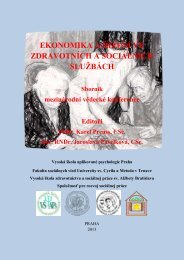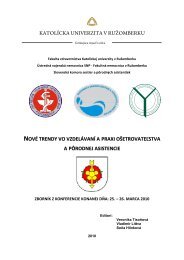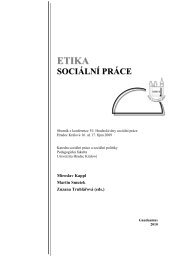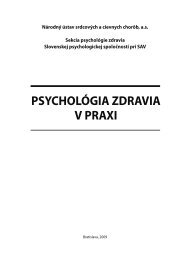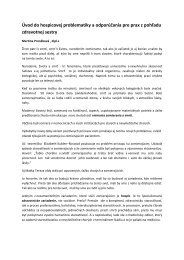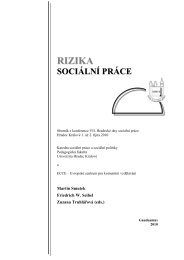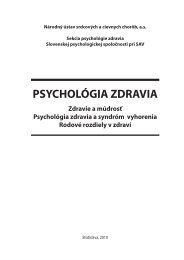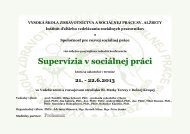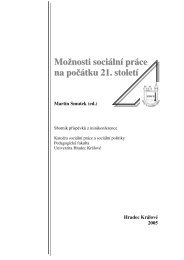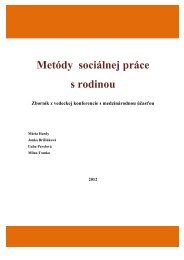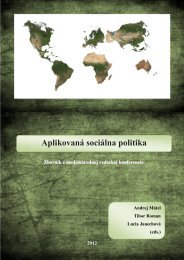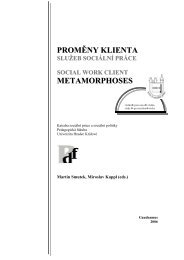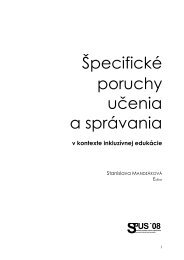Zmena klÃmy â možný dopad (nielen) na obyvateľstvo - Prohuman
Zmena klÃmy â možný dopad (nielen) na obyvateľstvo - Prohuman
Zmena klÃmy â možný dopad (nielen) na obyvateľstvo - Prohuman
Create successful ePaper yourself
Turn your PDF publications into a flip-book with our unique Google optimized e-Paper software.
strategy further sets objectives and policies for 13 specific thematic areas: Energy,<br />
Transport, Low carbon technologies, Buildings, Industry, Services, Agriculture,<br />
Solid waste, Spatial planning, Forests, sinks, biodiversity, Waters, Health, Natural<br />
disasters. Across these thematic areas, a number of sectors and technologies are<br />
defined that are already or should be included in the green growth (from energy<br />
efficiency with intellectual services and building refurbishment to local communities<br />
providing local services that reduce the demand for transport).<br />
The holistic feature of the Slovenian Low-Carbon Strategy is the result of several<br />
integrative processes in general policy planning and implementation as well<br />
as in relevant sectoral and cross-sectoral policies during the past decade. Furthermore,<br />
in the participatory process of building the strategy and preparing the<br />
first draft by the Government Office of Climate Change, the holistic and systemic<br />
character of the process, in line with the principles of sustai<strong>na</strong>ble development, as<br />
well as the five constitutive elements of the new Integral Approach were carefully<br />
nurtured.<br />
The integral character of the Draft Low-Carbon Strategy<br />
The strategy elements developed through the participatory process of thematic<br />
workshops and ema<strong>na</strong>ting from research basis already partially included the four<br />
‘worlds’ and the centre as defined in Integral Approach. In fi<strong>na</strong>lizing the SWOT<br />
a<strong>na</strong>lysis and the strategy’s vision, these “integral pillars” were, on the basis of<br />
communication with Lessem and Schieffer, further stressed by Darja Piciga. In<br />
a rather simplistic form, these pillars are expressed by the statements in the SWOT<br />
and vision chapters as follows:<br />
MORAL CORE: Acceptance in principle of the values of sustai<strong>na</strong>ble development,<br />
high population awareness on climate change and the degree of motivation to act<br />
for the common good. Slovenia is in 2050 a society with a developed value system<br />
and conscious/enlightened holistic individuals and organizations.<br />
NATURE & COMMUNITY: Healthy and biologically diverse ecosystems are<br />
adapted to climate change through <strong>na</strong>tural processes and sustai<strong>na</strong>ble ma<strong>na</strong>gement.<br />
Preserved <strong>na</strong>ture, including water quantity and quality, sustai<strong>na</strong>ble forests<br />
and biodiversity, provides ecosystem services. Slovenia is in 2050 a welfare society<br />
and the land of equal opportunities with high the social cohesion, individuals<br />
and organizations are connected with the social environment.<br />
CULTURE & SPIRITUALITY: Building on Slovenia’s cultural heritage and the rich<br />
diversity of cultural influences. Supply networks in sustai<strong>na</strong>ble food and energy<br />
138




